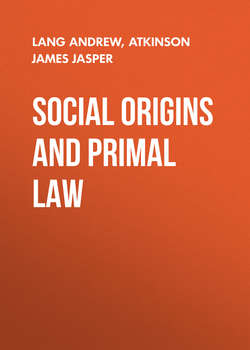Читать книгу Social Origins and Primal Law - Lang Andrew - Страница 25
CHAPTER III
TOTEMS WITHIN THE PHRATRIES
OBJECTIONS TO MR. FRAZER'S EARLY THEORY
ОглавлениеWe shall later see that Messrs. Spencer and Gillen appear to advance, but also to qualify out of existence, a theory of a motive for an exogamous bisection of earlier non-exogamous local totem groups. They practically explain away their own explanation of – the great bisection, but it rests, while it exists, on certain recently discovered facts, which, in turn, are fatal, perhaps, to any theory that a tribe had originally but two totems, which became 'phratries,' on being subdivided into other totems. The new facts accepted and theorised on by Mr. Frazer and Mr. Spencer, would make it seem perhaps impossible that a tribe like the Thlinkets should originally have possessed but two 'clans' or totems. The facts, as stated by Mr. Spencer, in 1899, are these, or rather, this is his hypothesis founded on his facts. 'In our Australian tribes the primary95 function of a totem group is that of ensuring, by magic means, a supply of the object which gives its name to the totem group.'96 Mr. Frazer says, 'in its origin Totemism was, on our theory, simply an organised and co-operative system of magic… Each totem group was charged with the superintendence and control of the particular department of nature from which it took its name…'97
But this is hardly the origin of Totemism, so long as we are not told how, or why, each totem group took its name from a department of nature. Had it the name, before it worked magic for its eponymous object, or did it take the name because it worked the magic?
Again, there are dozens of such departments,98 which implies the existence of dozens of organised and co-operative totem groups: not of an original poor pair of such groups alone. Can we believe that, on Mr. Frazer's earlier theory, the Thlinkets formed but two such groups, one 'charged with' the duty to mollify the Wolf, the other to take care of the interests of the Raven? Manifestly this is unlikely. I elsewhere oppose this theory of the magical Origin of Totemism, made at first to fit the case of the Arunta and cognate tribes. If organised co-operation in magic is the source of Totemism, we may be pretty confident that no tribe began by appointing one half of all its members to do magic to propagate ravens, and the other half to mollify wolves. This would indicate, in the magical and co-operative tribe, a most oddly limited and feebly capitalised flotation of the company – merely 'Wolf and Raven.' No tribe would select ravens as the article of food which most required careful propagation and preservation, even if the Wolf most demanded to be propitiated and mollified. The new Australian facts (whatever their interpretation) are fatal to the older idea that a tribe could have had only two original totems: an idea which we may perhaps regard as now abandoned, at least by Mr. Frazer.
Thus Mr. Spencer himself remarks that, in Arunta tradition, there were numbers of totem groups before the great dichotomous division was made. That is my own opinion: though I do not hold it for Mr. Spencer's reasons, or believe in any 'bisection.'
95
My italics.
96
J. A. I., N.S. i. 278.
97
Ibid. p. 282.
98
Mr. Mathews counts thirty-four totems in the Dilbi, and as many in the Rupathin 'phratries.' Proc. Ray. Soc. N.S.W. xxxi. 157-158.
